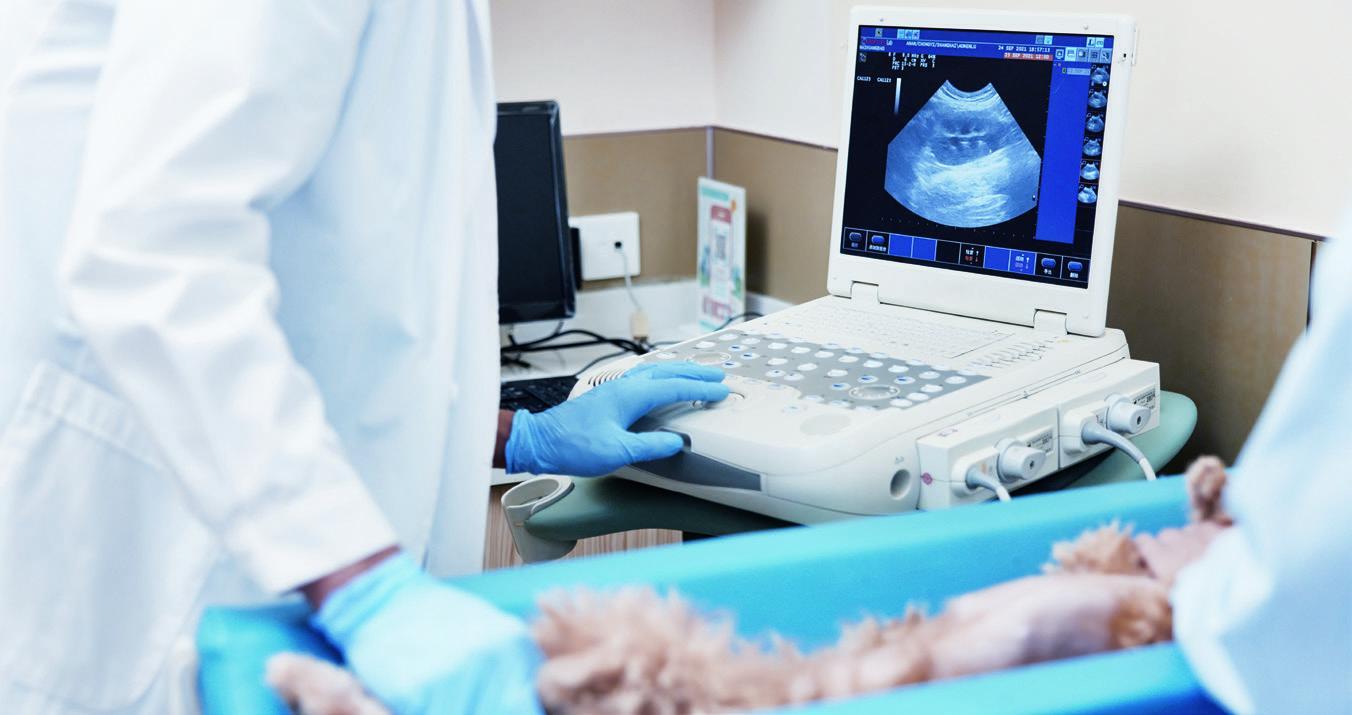The Pet Medical Market Is to Accelerate Expansion
By Jenny Hu

Nowadays, pets play a major role in most peoples lives, mainly as friends and family members providing companionship. The emotional and physical states of their pets affect their owners hearts all the time, and pet owners are willing to pay for their petshealth and happiness. This also means that Chinas pet medical market will grow further.
Aging pets + healthy pets
As the income of Chinese residents increases and the number of pet owners grows, the types of pet consumption-related goods and services continue to expand, and the scale of the domestic pet industry is expanding rapidly. In 2020, the scale of Chinas urban pet market was close to RMB 300 billion, and the compound growth rate reached 32.8% from 2015 to 2020. With the continuous improvement in the pet penetration rate into families and industry maturity, the pet industry will maintain steady growth. According to an iResearch forecast, in the next three years, the compound growth rate of Chinas pet industry will be 14.2%, and the scale will reach RMB 445.6 billion by 2023.
From the perspective of the industry structure of the pet industry, pet medical treatments is the second largest consumption field relating to pets in China. Compared with the United States, which already has the worlds largest economic pet market, the pet dog and cat breeds, other than a small amount of rural Chinese dogs and cats, the other breeds are basically identical with those in the United States, which means that the disease spectrum and incidence of pets in China and the United States are similar, yet medical costs in the United States are 4.3 times those in China. Based on an approximate proportion of the number of cats and dogs in China and the United States, the size of Chinas medical market may exceed RMB 100 billion in the future, indicating a huge market space.
At present, most of the pets in China are young, with most of them being between 2 and 5 years old. From 2022 to 2026, a large number of pets will reach old age (more than 8 years old). With the increase in petsages, the incidence of pet diseases will greatly increase and medical demand will further increase. At the same time, due to the motivations of emotion and companionship, the role of pets is gradually changing to that of family members and companions. Pet owners will actively pursue health, happiness and companionship of their pets, and have enough medical awareness to take their pets for regular physical examinations, timely medical treatment and vaccinations.
Policy to accelerate the roll out of pet drugs
Starting with the Flower and Bird Market in the early 1990s, over 30 years of development, the domestic pet industry has experienced a period of enlightenment, gestation and rapid development, and has now entered a stable and mature period of orderly growth. The pet medical industry chain has taken its initial shape, in which pet medicine (including vaccines) and pet hospitals account for the largest proportion.
From the perspective of the global competition pattern of pet drugs, the top 4 animal health enterprises in the world — Zoetis, Boehringer, Merck animal health and Elanco — account for nearly 40% of the market share of the global animal health market. At present, the top 10 imported drugs in the sales of pet drugs and vaccines in China are basically from these four companies. Domestic pet medicines and vaccines are in their infancy, and there are no leading companies in these fields yet.
On the one hand, large animal health enterprises in China mainly focus on drugs for economic animals. Compared with economic animal drugs, pet drugs used to be a relatively small market. In 2016, the pet drug market only accounted for 8% of the entire animal medicine market, and the profits were not enough to support large pharmaceutical enterprises investing in research and development in this area.
On the other hand, the research and development of new pet drugs is a high-investment and long-term process. The research and development process involves first discovering the drug and finally registering for an application after demonstrating a variety of pre-clinical and clinical trial successes, and generally takes about 5 years. Chinas pet market has only started to grow rapidly in recent years. At present, there are only a few approvals for domestically-developed pet drugs, and there is not enough time to support the launch of a large number of pet drugs.
In the face of the increasing demand for pet medicine in China, in recent years, the State has issued a number of pet medicine-related standards and policies. In the short term, depending on policy preferences, domestic economic animal veterinary drugs for pet use and human drugs for pet use will become the main driving force behind domestic pet drugs growth.
In the long run, rapid growth in the number of pets, the increasing intended consumption of pets, an increase in per capita disposable income and the gradual aging of pets will further promote the growth of the pet medical market in the future. The growth on the demand side will promote the development of the drug market on the supply side. Individual pet owners purchase pet medicines mainly for general health care and deworming, and the consumption of other pet medicines is mostly directly influenced by vets. According to the Survey carried out by AlphaWise, approximately 50% of pet owners have changed the brand of pet consumer products based on the recommendation of veterinarians. In the future, the vertical supply of pet hospitals and pet drug companies will become the main source from which to drive the growth of domestic pet drugs.
Pet hospital chain will become the future trend
According to the report of the Changjiang Securities Research Institute, the scale of the current domestic pet hospital market is over RMB 20 billion and may exceed RMB 40 billion after 2023.
However, more and more pet owners are reluctant to go to pet hospitals because of the high cost, as well as unguaranteed medical treatments. Experienced pet owners will buy medicines for minor ailments by themselves which have been prescribed by vets before. The main profit source of pet hospitals will gradually become“treatment of minor diseases in the first few years for new pet owners + fixed annual pet vaccines + neutering operations for new pets + treatment of serious diseases”.
As the pet population growth slows, income from “new pet owners”and neutering operations will shrink. In the future, the large number of pets in the existing market will promote the growth of serious disease and surgery-related businesses, and large pet hospitals with professional medical equipment will have greater advantages.
The pet hospital industry in China has entered a period of industry integration. The investment of capital promotes the rapid development of the whole industry, and also promotes the evolution of pet diagnosis and treatment toward industrialization and centralization. Large chain hospitals will further occupy the market.
From the perspective of brand effect, 58.9% of pet hospitals have less than 10 patients per day on average. Many pet hospitals face the problem of attracting customers. General pet hospitals spend only 0.3% on marketing and promotion, and large chain pet hospitals have more brand advantages in terms of attracting customers.
From the perspective of talent training, 52.5% of the cost in pet hospitals comes from human expenditure. Large chain pet hospitals have better training mechanisms, and it is easier to recruit better doctors with the advantage of large platforms.
From the perspective of scale advantage, rent costs in first-tier cities is too high, and the income of private pet clinics can hardly cover this cost. With strong financial strength, chain pet hospitals have created scale advantages due to their multi-tier city layout, and the cost input for medical equipment is greatly reduced with their strong upstream bargaining power.
In terms of profitability, according to the “Management Measures for Animal Diagnosis and Treatment Institutions”, pet hospitals need at least three practicing veterinarians and medical equipment such as X-ray and B-ultrasound machines, which cost a lot if they are fully compliant. At present, 35.4% of pet hospitals make less than 10% profit. In the future, with the further implementation of supervision, small and medium-sized pet hospitals will face increasing pressure in terms of capital investment. Large chain pet hospitals will recover costs faster by virtue of capital and experience advantages, further putting pressure on the living space of small institutions.
Online pet medical market sees rapid growth
In recent years, the online pet medical market has been expanding rapidly, and more and more pet owners have flocked to the online pet medical market. With the enhancement of the richness of online products and services, pet owners have a stronger online consumption power, and the annual per capita consumption level has increased year by year. According to the Observation Report on Pet Medical Consumption in 2020, female pet owners are the main health guardians. Women are responsible for a significantly higher amount of online pet medical consumption than that of men, and their per capita consumption level is also higher than that of men. New white-collar workers and Generation Z make a high contribution to online pet medical consumption. Although Generation Z pet owners are young, they have great potential in terms of pet medical consumption. Mothers and new white-collar workers lead the overall market in terms of per capita consumption.
Since the second quarter of 2019, the offline pet medical service market has developed rapidly online. Instead of relying solely on offline pet hospitals for consultations, pet owners are gradually trying out online medical services, and the number of people searching for and consuming online medical services is increasing. According to the Survey, nearly 60% of pet owners have experienced taking their pets to the vets, and seeking help from veterinary medical professionals is an important thing for pet owners to choose when they need to.
However, at present, the overall penetration rate of online medical services is still low. The most popular service is online purchase and offline use, mainly for vaccines. In the future, preventive medicine can be made into standardized products for online purchase and offline use. Online diagnosis and treatment (remote consultation) currently has a low penetration rate, but the willingness to use this in the future ranked second. With the gradual improvement in Internet medical treatment, online diagnosis and treatment, as an important way of attracting customers offline, will have great potential for development in the future.
Industry insiders said that for pet hospitals, medical treatment is a traditional offline service industry, which requires testing, results and data interpretation to exclude the possibility of disease. Purely online diagnosis and treatment is a false proposition, and online diagnosis and treatment is simply a way to divert customers to offline services after 3-5 rounds of simple communication.
- China’s foreign Trade的其它文章
- Automotives Healthcare and Consumer Electronics Are Top 3 Industries
- Total Sales of the Works of the Top 50 Artists from Hurun Global List Dropped
- The Construction of Central Legal Services Districts Is Forthcoming
- Mediation Greatly Facilitates the Development of Intellectual Property Dispute Resolution
- Accelerating Green Technology Innovation to Achieve Carbon Peaking and Neutrality Goals
- Cross-border E-commerce Market Remained Firm During Double 11 Shopping Festival

